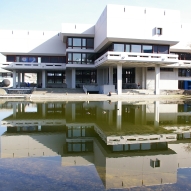| Dokumentenart: | Artikel | ||||||
|---|---|---|---|---|---|---|---|
| Titel eines Journals oder einer Zeitschrift: | Inorg. Chem. | ||||||
| Band: | 46 | ||||||
| Seitenbereich: | S. 4336-4356 | ||||||
| Datum: | 2007 | ||||||
| Institutionen: | Chemie und Pharmazie > Institut für Organische Chemie > Lehrstuhl Prof. Dr. Burkhard König | ||||||
| Identifikationsnummer: |
| ||||||
| Dewey-Dezimal-Klassifikation: | 500 Naturwissenschaften und Mathematik > 540 Chemie | ||||||
| Status: | Veröffentlicht | ||||||
| Begutachtet: | Ja, diese Version wurde begutachtet | ||||||
| An der Universität Regensburg entstanden: | Ja | ||||||
| Dokumenten-ID: | 6277 |
Zusammenfassung
New 1,4,7,10-tetrazacyclododecane ([12]aneN4 or cyclen) ligands with different heterocyclic spacers (triazine and pyridine) of various lengths (bi- and tripyridine) or an azacrown pendant and their mono- and dinuclear Zn(II), Cu(II), and Ni(II) complexes have been synthesized and characterized. The pKa values of water molecules coordinated to the complexed metal ions were determined by ...

Zusammenfassung
New 1,4,7,10-tetrazacyclododecane ([12]aneN4 or cyclen) ligands with different heterocyclic spacers (triazine and pyridine) of various lengths (bi- and tripyridine) or an azacrown pendant and their mono- and dinuclear Zn(II), Cu(II), and Ni(II) complexes have been synthesized and characterized. The pKa values of water molecules coordinated to the complexed metal ions were determined by potentiometric pH titrations and vary from 7.7 to 11.2, depending on the metal-ion and ligand properties. The X-ray structure of [Zn2L2]mu-OH(ClO4)3.CH3CN.H2O shows each Zn(II) ion in a tetrahedral geometry, binding to three N atoms of cyclen (the average distance of Zn-N = 2.1 A) and having a mu-OH bridge at the apical site linking the two metal ions (the average distance of Zn-O- = 1.9 A). The distance between the Zn(II) ion and the fourth N atom is 2.6 A. All Zn(II) complexes promote the hydrolysis of 4-nitrophenyl acetate (NA) under physiological conditions, while those of Cu(II) and Ni(II) do not have a significant effect on the hydrolysis reaction. The kinetic studies in buffered solutions (0.05 M Tris, HEPES, or CHES, I = 0.1 M, NaCl) at 25 degrees C in the pH range of 6-11 under pseudo-first-order reaction conditions (excess of the metal complex) were analyzed by applying the method of initial rates. Comparison of the second-order pH-independent rate constants (kNA, M-1 s-1) for the mononuclear complexes ZnL1, ZnL3, and ZnL8, which are 0.39, 0.27, and 0.38, respectively, indicates that the heterocyclic moiety improves the rate of hydrolysis up to 4 times over the parent Zn([12]aneN4) complex (kNA = 0.09 M-1 s-1). The reactive species is the Zn(II)-OH- complex, in which the Zn(II)-bound OH- acts as a nucleophile, which attacks intermolecularly the carbonyl group of the acetate ester. For dinuclear complexes Zn2L2, Zn2L4, Zn2L5, Zn2L6, and Zn2L7, the mechanism of the reaction is defined by the degree of cooperation between the metal centers, determined by the spacer length. For Zn2L7, having the longest triaryl spacer, the two metal centers act independently in the hydrolysis; therefore, the reaction rate is twice as high as the rate of the mononuclear analogue (kNA = 0.78 M-1 s-1). The complexes with a monoaryl spacer show saturation kinetics with the formation of a Michaelis-Menten adduct. Their hydrolysis rates are 40 times higher than that of the Zn[12]aneN4 system (kNA approximately 4 M-1 s-1). Zn2L6 is a hybrid between these two mechanisms; a clear saturation curve is not visible nor are the metal cores completely independent from one another. Some of the Zn(II) complexes show a higher hydrolytic activity under physiological conditions compared to other previously reported complexes of this type.
Metadaten zuletzt geändert: 29 Sep 2021 07:30



 Altmetric
Altmetric